There Goes This Art of Manliness: Naturism and ... - LA84 Foundation
There Goes This Art of Manliness: Naturism and ... - LA84 Foundation
There Goes This Art of Manliness: Naturism and ... - LA84 Foundation
You also want an ePaper? Increase the reach of your titles
YUMPU automatically turns print PDFs into web optimized ePapers that Google loves.
<strong>Naturism</strong> <strong>and</strong> Racial Hygiene in Germany<br />
ity. 115 While imperialism <strong>and</strong> nationalism were strong in Germany <strong>and</strong> eventually<br />
helped to bring about the first world war, at the same time, Germany was<br />
experiencing a dramatic decline in population which was explained by various<br />
theories at the time. l16 Racial hygiene was supposed to improve the stock <strong>of</strong> a<br />
population by encouraging people with “positive” genes to procreate extensively<br />
<strong>and</strong> by hindering those with “negative” ones to procreate at all. Eventually<br />
this led to the perversion <strong>of</strong> the Nazi racial theories. The physical<br />
education <strong>and</strong> the hygiene movements have been closely connected in Germany<br />
particularly since the international hygiene exhibition in Dresden in 1911. 117<br />
A positive selection for the sake <strong>of</strong> breeding a better population (Zuchtwuhl)<br />
was advocated by many <strong>of</strong> the racial hygienists. <strong>This</strong> was, however, not that<br />
easy in a time when in some areas fifty percent <strong>and</strong> more <strong>of</strong> the population was<br />
supposed to have syphilis 118 which did not have a reasonable cure at the time <strong>and</strong><br />
was spread particularly by prostitution. The personal fear <strong>of</strong> syphilis, the “lust<br />
epidemic ,” 119 was increased by the national campaigns against the population<br />
decline as syphilis was partially to blame for this: syphilis was passed from the<br />
prostitute to her customer, from the customer to his (future) wife <strong>and</strong> from the<br />
mother to the child. It was responsible for the high infant mortality, the<br />
relatively low life expectancy <strong>and</strong> the low recruitment possibilities for the army<br />
particularly in the cities. It was thus a threat to the very core <strong>of</strong> German<br />
imperialism. The German Turners who were proud <strong>of</strong> their art <strong>of</strong> manliness<br />
were no different:<br />
At the time <strong>of</strong> the XIth German Turnfest in Frankfurt (1908) the main roads were<br />
crowded during the festive days, but the roads leading to the brothels were so full<br />
<strong>of</strong> men that it was dangerous to walk there. When one Turner left the brothel three<br />
others rushed in. Finally the doors had to be locked with many st<strong>and</strong>ing still in line<br />
outside. 120<br />
Many citizens were afraid that due to reaching into other parts <strong>of</strong> Europe,<br />
115. Cf. Helmut Böhme, Prologema zu einer Sozial- und Wirtschaftsgeschichte Deutschl<strong>and</strong>s im 19. und 20.<br />
Jahrhundert (Frankfurt: Suhrkamp, 1968); Jürgen Kroll, Zur Entstehung und Institutionalisierung einer naturwissenschaftlichen<br />
und sozialpolitischen Bewegung: Die Entwicklung der Eugenik/Rassenhygiene bois zum<br />
Jahre 1933 (Diss. Tübingen, 1983); Heinz-Georg Marten, Sozialbiologismus. Biologische Grundpositionen der<br />
politischen Ideengeschichte (Frankfurt: Campus, 1983); Michael Hughes, Nationalism <strong>and</strong> Society. Germany<br />
1800-1945 (London: Edward Arnold, 1988). 130-163.<br />
116. J. Borntraeger, Der Geburtenrückgang in Deutschl<strong>and</strong>. Seine Bewertung und Bekämpfung (Würzburg:<br />
Kabitzsch, 1913); Walter Claaßen, “Die Abnehmende Kriegstüchtigkeit in Deutschl<strong>and</strong> in Stadt und L<strong>and</strong> von<br />
1902-1907,” Archiv für Rassen- und Gesellschaftsbiologie 6 (1909):1, 73-77; Hermann Paull, Die Lebenskrise<br />
des deutschen Volkes. Geburtenrückgang, Fürsorgewesen und Familie. (Berlin: Dümmler, 1929); John E.<br />
Knodel, The decline <strong>of</strong> fertility in Germany. 1871-1939 (Prmceton: NJ: Princeton University Press, 1974).<br />
117. Eerke U. Hamer, Spielbewegung, 319-361; Ludwig Flügge, “Rassenbiologie und Sport,”<br />
Rassenhygiene und Sexualethik (Berlin: Literarisches Institut, 1924) 69-83.<br />
118. The death-rate <strong>of</strong> persons infected by syphilis was supposed to be 30 to 75 p.c. higher than <strong>of</strong> nonsyphelitic<br />
population. Cf. Max von Gruber, Die Pflicht gesund zu sein (München: Ernst Reinhardt, 1913), 13;<br />
Hermann Werner Siemens, Grundzüge der Vererbungslehre, Rassenhygiene und Bevölkerungspolitik (München:<br />
Lehmann, 1930), 90; Walter Claassen, “Das Ausbreiten der Geschlechtskrankheiten in Berlin 1892-1910,“Archiv<br />
für Rassen- und Gesellschaftsbiologie 10 (1913): 4,479-83; Erich Stern, Die Erziehung und die sexuelle Frage.<br />
(Berlin: Union Deutsche Verlagsges., 1927), 171-300; A. Blaschko, “Die Geschlechts-krankheiten und ihre<br />
soziale Bedeutung,” Zentralinstitut für Erziehung und Unterricht, ed., Eonführung in die Sexualpädagogik.<br />
(Berlin: Mittler & Sohn, 1921) 81-101.<br />
119. Bilz, Jubiläumsausgabe, 1362-69.<br />
120. Siegfried, quoted in Ungewitter, Nackt, 67.<br />
155

















